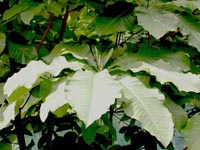Resource Library
Plant of the Week: Umbrella Magnolia
The University of Arkansas System Division of Agriculture does not promote, support or recommend plants featured in "Plant of the Week." Please consult your local Extension office for plants suitable for your region.
Plant of the Week
Umbrella Magnolia
Latin: Magnolia tripetala

Tropical lushness is in with gardeners attempting to create a garden with the look and feel of a summertime paradise. Achieving this look relies on the use of plants with super-sized leaves. One of our native trees, the Umbrella Magnolia (Magnolia tripetala), fits the tropical motif admirably and can add a feeling of lushness to any landscape.
This deciduous magnolia ranges down the spine of Appalachia and across the woodlands of the mid-South to as far west as eastern Oklahoma. It’s an understory tree that grows along cool, moist mountain streams and next to swampland. In the wild, it usually grows about 30 feet tall and wide.
In Arkansas it occurs primarily in the Ozarks and Ouachita mountains.
Umbrella magnolia has a smooth, gray bark and relatively few branches. The main trunk sends up a number of fast growing suckers from near the base. In other trees, this would be taken as a sign of distress, but in umbrella magnolia it seems to be just a natural occurrence.
The most remarkable thing about this species is its nearly 2-foot long leaves that are 8 inches across. They’re produced at the ends of the branches in a whorl, thus accounting for the common name. It has the look and texture of a banana, albeit a branched one. Fall color is not remarkable, but it’s remarkable when a blizzard of these large leaves fall off of the tree after the first light frost.
The bowl shaped white flowers are to 10 inches across with six to twelve narrow petals called tepals. They have a distinctive odor, described by one author as having "a strong goat smell", which was probably not intended as an endorsement.
The umbrella magnolia was introduced to the gardening world by an Englishman, Mark Catesby (1679-1749), who spend almost 10 years exploring the southeastern states looking at the botanical wonders of the area. His illustrated book on the flora and fauna of the region was published to subscribers between 1731 and 1748.
When Linnaeus unified plant naming he goofed with this species. Catesby used the pre-Linnaean system of naming developed by fellow countryman, Thomas Ray, and called the new discovery "Magnolia amplissimo flore albo, fructo coccinea." This unwieldy moniker was simplified by Linnaeus’ binomial system to Magnolia tripetala. Linnaeus apparently used Catesby’s description for the plant, but somehow confused the number of petals, deciding there were only three. Even the Father of Taxonomy is permitted a gaff now and then.
This large-leafed magnolia is similar to Magnolia macrophylla, which is called Bigleaf Magnolia. This species has an even larger leaf but is not as common in the wild. In Arkansas it’s found in only Mississippi County.
Using umbrella magnolia in the landscape requires the right setting. It makes a great addition along a natural or manmade stream in a shade garden. Or, if a sunny site is available it makes an interesting specimen. Windy locations cause the leaves to tatter, so avoid too much wind exposure. Keep it watered during periods of dry weather. You’ll not find it at your local nurseries, but native plant nurseries often list it.
By: Gerald Klingaman, retired
Extension Horticulturist - Ornamentals
Extension News - July 8, 2005
The University of Arkansas System Division of Agriculture does not maintain lists of retail outlets where these plants can be purchased. Please check your local nursery or other retail outlets to ask about the availability of these plants for your growing area.